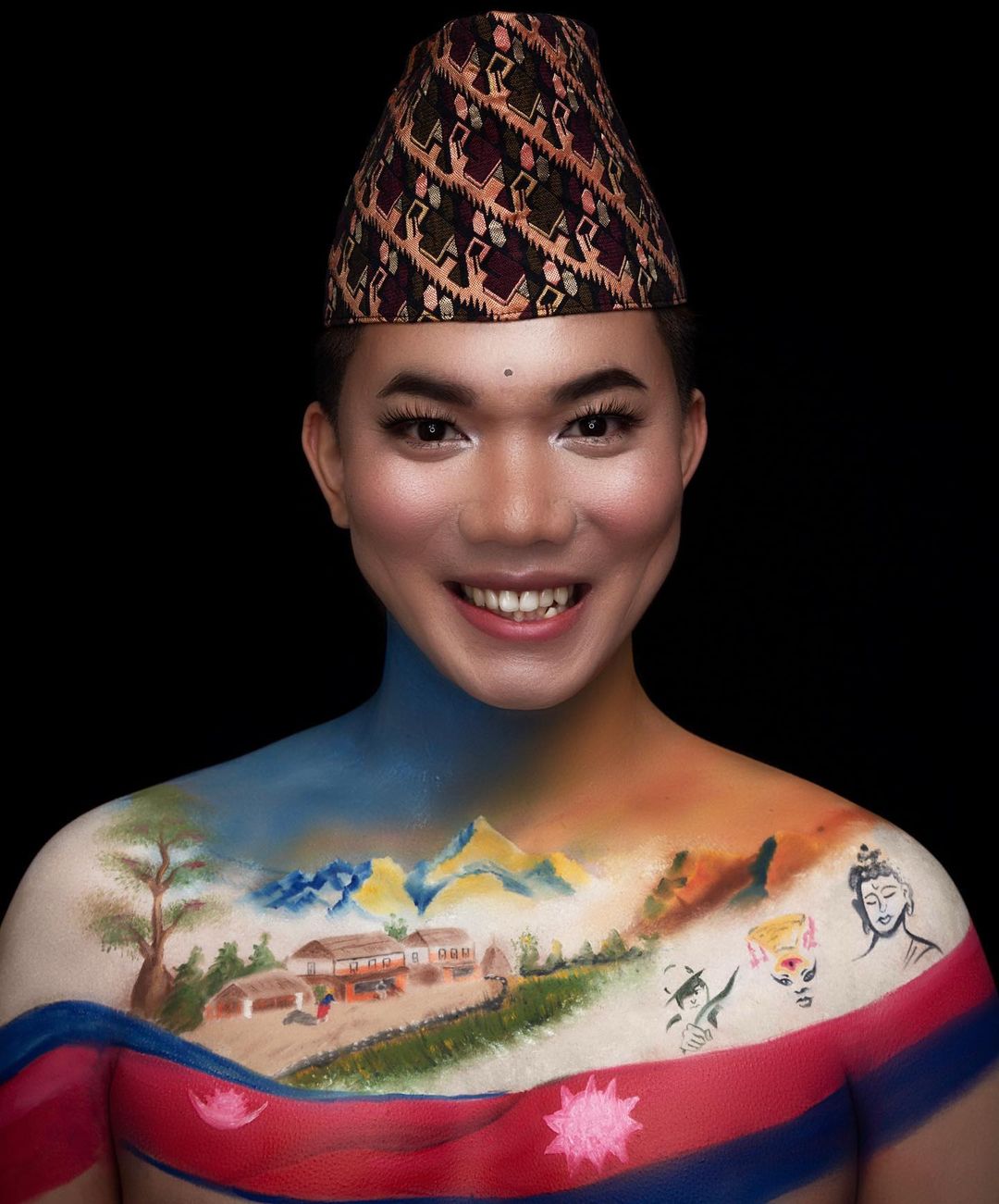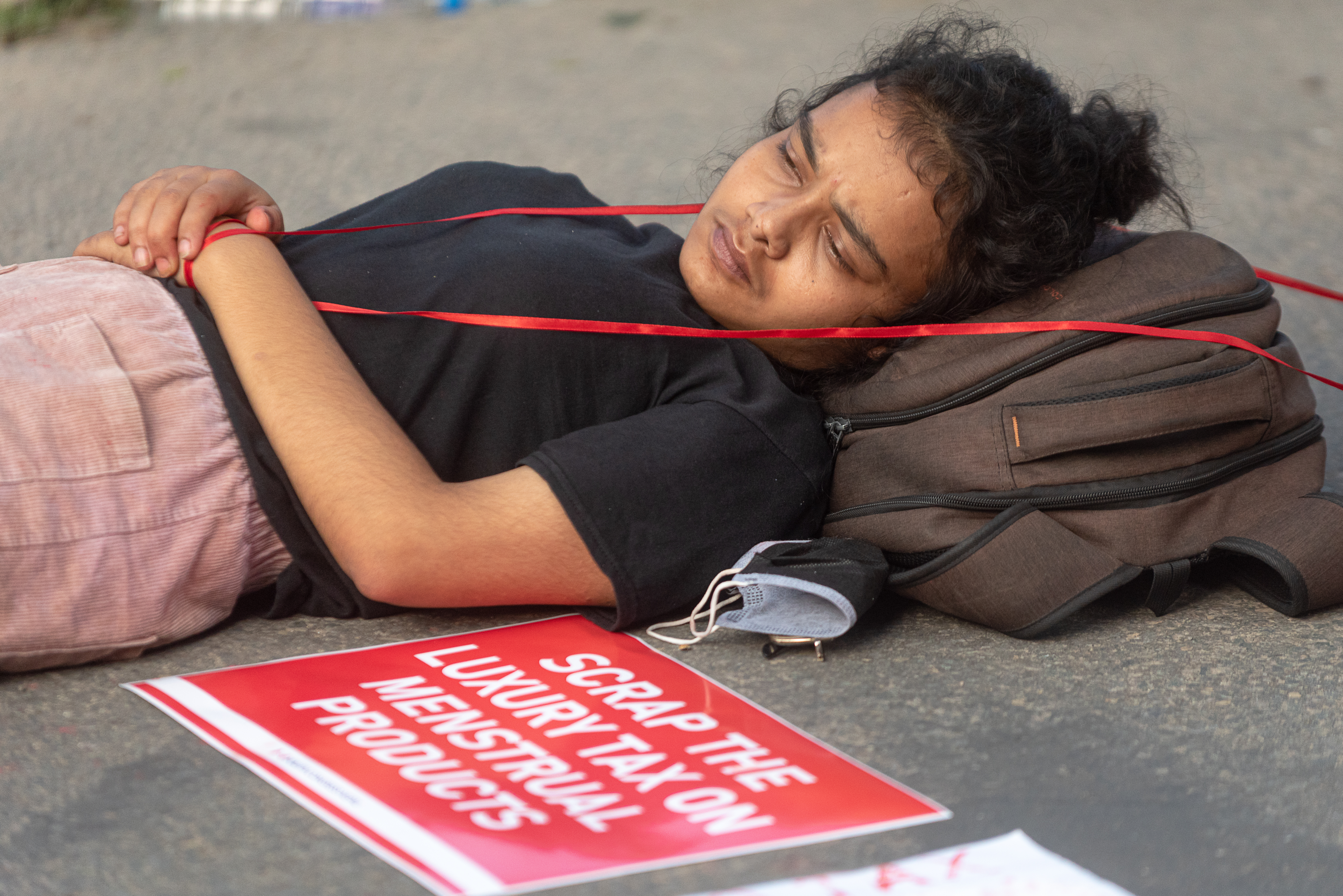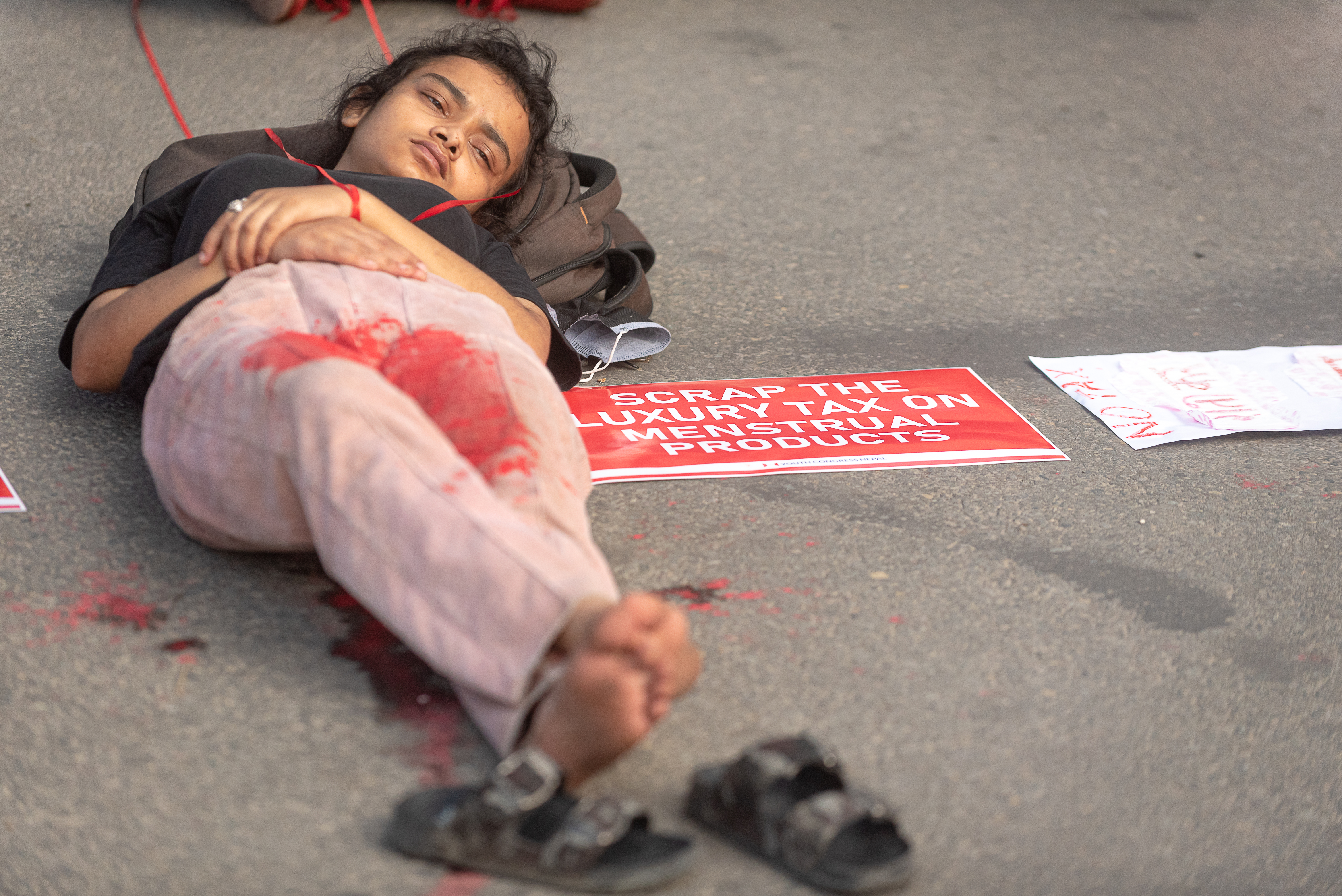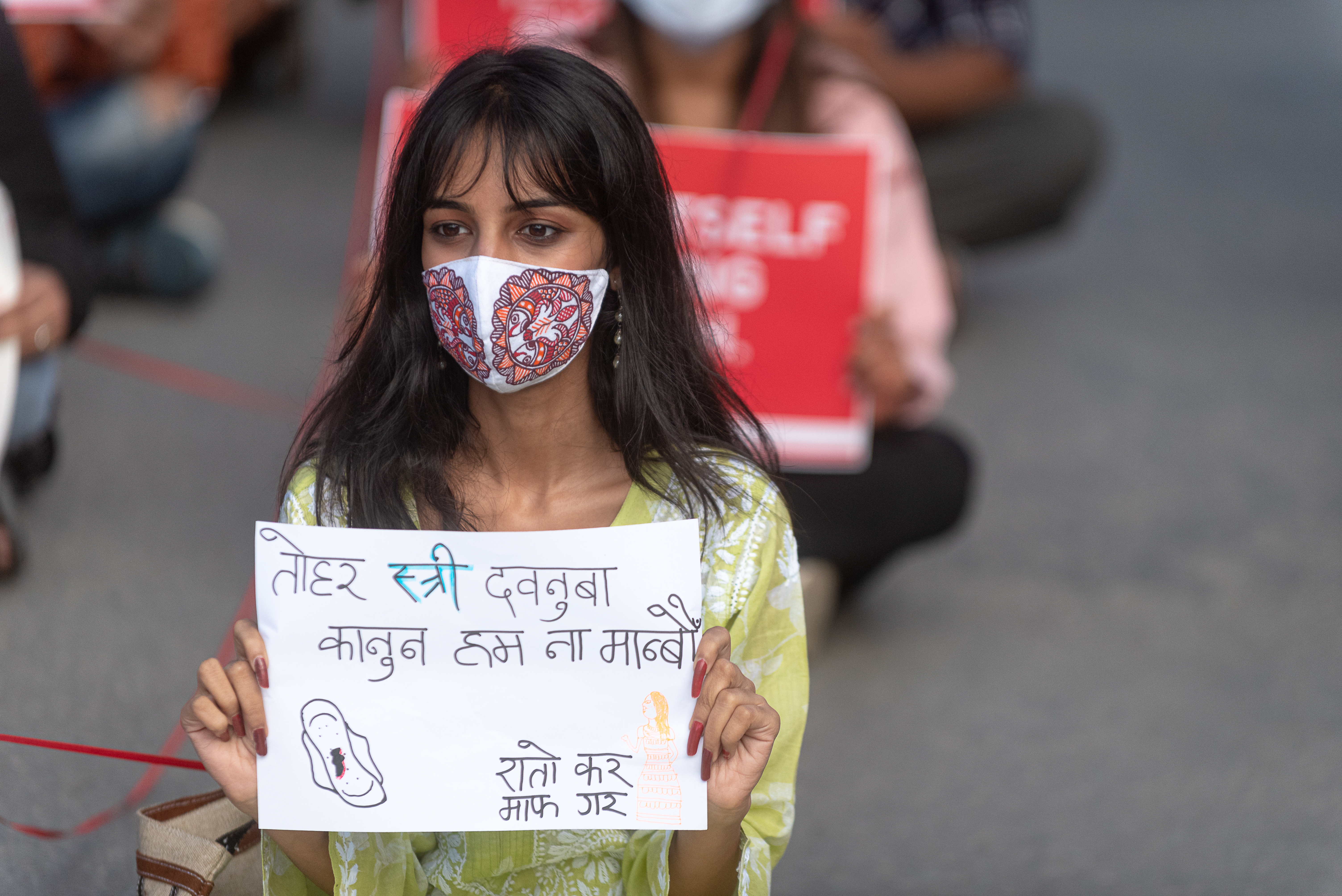Anish Tamang: Putting his body and soul into it
You may—nay, must—have come across Anish Tamang’s extreme body painting transformation videos as you scrolled through TikTok.
An aspiring make-up artist recognized for his amazing body paintings, Tamang, who finds great joy in expressing himself this way, creates works of art with captivating details.
Growing up as a feminine boy, Tamang struggled to accept himself. Having to deal with constant bullying by his peers, he wrestled with his identity and tried to hide behind traditional gender norms. “We were only taught the stereotypical roles of a boy and a girl and, as a child, I didn’t know my being different was okay,” shares the now 27-year-old. “I tried so hard to be someone I wasn’t”.
One thing that always made him feel better, though, was make-up. After watching his mother, another make-up lover, spruce herself up, he wanted to try doing it on himself.

All his life he had dreamt of one day working as a flight attendant and he thus studied Bachelors in Hotel Management. But things didn’t exactly go as planned.
In 2012, Tamang started modeling. “In my modeling years, I would never be satisfied when other people did my make-up,” confesses Tamang. “So I always did it myself”. With no plans of taking it up professionally, he continued to get better. It was only when he did a make-up look on his sister, in 2015, that he realized that this could be a possible career path.
Also read: Souvenir’s Gallery Café: Of delectable cuisines and canvases
“Looking at my sister, I fell in love with the idea of transforming a human body and I realized that this is something I wanted to keep doing.” He thus took it up as a profession in 2018 and, today, Tamang is a full-time self-taught make-up artist and body painter.
At the start, Tamang struggled with the complications of his new job. “Earlier, I used to feel so free and paint whatever came to my mind,” he adds. “But now my expression has to incorporate people’s expectations and current trends.” Yet he still does his best possible job, both on himself as well as his clients.
In the beginning, he was only involved in facial make-up. Then he fell into depression. “I always felt so lost and everything felt rough and pointless in life. That is when body painting came to my rescue,” he says.

He remembers being struck by a dialogue from the 2019 movie ‘The Lion King’: ‘Remember who you are’. It touched him in a way nothing else had up to that time and he immediately wanted to give an expression to it.
The stars aligned, and Tamang came across a video of another makeup artist body-painting a movie scene. He knew that he had to do it too. He didn’t know how, he had never done it and he didn’t even know if he could. But after 10 hours of painting on himself, Tamang knew he had found his calling.
“At first, when I used to body-paint, it felt like I’d escaped reality. I forgot all the problems in my life. I could go on for hours and hours. And now, it has become a part of me. It reflects who I am today, what I’m going through, and how my heart is feeling.”
Also read: Behind the scenes with Fun Revolution TV
His social media presence grew with time as he started putting up content showcasing his incredible talent. More people appreciated him and he built a strong fanbase. Tamang doesn’t let negative comments online affect him much, and in fact believes Nepal will slowly come to accept all those who transcend traditional gender categories.
To support himself, Tamang also teaches make-up and at times does special-effect make-up.
It takes him nine to 13 hours to complete a body paintwork. “These past couple of years have taught me to be patient with my work, to watch myself learn and to grow with every painting I do,” he shares.
Ultimately, Tamang wants to create a space where people aren’t obliged to give up their passion to earn money. He hopes the scope of body-painting in Nepal expands as people come to realize how it is an amazing medium where art, expression, and identity complement each other.
_20211019105009.webp)
When you do something so unconventional, there are bound to be detractors. How does Tamang deal with them?
“There is always going to be someone who doesn’t like you, who you can never impress,” Tamang says. “That is when you stop caring about what they think and continue with what makes you happy.”
Mohani: The Newa complement to Dashain
The Newa community celebrates Mohani, which coincides with Dashain, as one of their most important festivals. The festival marked for 15 days by worshiping the Astamatrika goddesses has many parallels with Dashain.
Dashain, as it falls after the end of Indra Jatra, also marks the end of the plantation season and the start of autumn. It is free time for the Newa community and they take this time to worship.
According to cultural expert Om Prasad Dhaubhadel, the name ‘Mohani’ refers to a black tika made by the Newa people that is believed to have the power of putting others under one’s control.
The celebration of Mohani dates back to the Licchhavi period (400-750 CE) when the Valley was still divided into many kingdoms. Statues and sculptures of the nine deities of goddess Durga and Astamatrika were put up around the kingdoms to protect people from enemies and intruders. They worshiped the goddesses to get the power to fight and take control during an enemy attack.
Mohani begins with the planting of barley seeds in the Agam Chhen, the room where the deities are worshipped, in every household. The barley grows into jamara in the next nine days. “We dedicate a day each to worship an Astramatrika goddess throughout Mohini,” says Dhaubadel.
On the first day, devotees visit the Bramhayeni temple to worship the goddess. On the second day, the goddess Maheshwari is worshipped. Goddess Kumari and Bhadrakali are worshipped on the third and fourth days respectively. On the fifth and sixth days of Mohani, Barahi and Indrayani are worshipped. On the seventh day, Mahakali is the one worshipped.
On the eighth day, goddess Mahalaxmi is worshiped and the entire family comes together to celebrate and observe a grand feast. This day is called ‘Kuchhi Bhwey’ in Newari where ‘Kuchhi’ refers to mana, a traditional Newari measuring instrument and ‘Bhwey’ refers to a feast. In the old days, it used to be a challenge for a normal family to afford beaten rice. So this day ensures that everyone has at least one or two mana of beaten rice once a year.
Also read: Cautiously optimistic on corona
“In the earlier times, there was a practice of eating the feast on turmeric leaves and we used to hear stories of how turmeric leaves would turn into plates of gold the next day,” says 49-year-old Bhubaneshwori Dangol, a resident of Sanepa, Lalitpur. “But now we only add a piece of turmeric leaf on the plate to honor our ancestors.
On the ninth day, the Tripura Sundari goddess is worshiped. This day is called ‘Syakwa Tyakwa’ and the Newa people perform Tampujaya (worship of their possessions and vehicles).
On the tenth day, also called Chala, the elders of the family put Mohani, the black tika, over red tika on the forehead and jamara on the ears of the younger members of the family to give blessings.
“During Mohani, we prepare all kinds of dishes for the feasts from different kinds of meat, beaten rice, a large variety of vegetables, achaar, choila, dhyakla, wa, and many more,” says Dangol.
Until the 15th day, people go for Nakhatya (feast) at their familys’ and friends’ homes to put on Mohini and tika, and to feast together.
“I think what makes Dashain special and stand out is how people of different communities have found a way to celebrate and present their art, culture, and traditions in their own unique way,” says 26-year-old Shreyashka Maharjan, student of Sociology and Cultural Photographer. “It's the same with Mohani, but what is different is that different Newa communities have their own way of celebrating,” he adds.
In Patan, the centuries-old Astamarika dance called Ga Pyakkan, one of the most artistic dances of the Valley, is performed during Mohini.
In Kathmandu, Pachali Bhairabh Jatra is organized on the sixth day of Mohani by the Jyapu community. In Bhaktapur, the Khadga Jatra begins on Biyaja Dashami whereby every family uses a khagda (scimitar with a thick long blade) to slice vegetables as sacrifice.
“For Newars, Mohani is a huge affair for showcasing their culture, and various aspects of their histo
Obituary | Laba Khatri: A footballer through and through
Birth: 1972, Lalitpur
Death: 4 October 2021, Lalitpur
Laba Khatri, a former FIFA referee, dedicated his life to football.
Khatri was an avid follower of the game since his school days, and with constant support of friends and family, decided to pursue a career in it.
Stepping into the field at the age of 17, Khatri played for the Kathmandu-based Friends’ Club. He then played top division football for Brigade Boys Club, Jawalakhel Youth Club, and Three Star Club. Besides Nepal, he also got to showcase his footballing skills with different clubs in India.
Khatri’s passion for football fluttered as he got more opportunities at the Three Star Club, and he started playing more national and international games.
His career took a new turn when he got injured while playing in India 1997: having sustained major injuries to his left leg, he had to stop playing to avoid further damage. But that could not take him away from football. After 10 years of playing, he decided to become a referee as he already had the experience of refereeing a couple of games even in his playing days.
In 2005 he completed his AFC Elite referee course from Bangladesh and went on to run games for some of the strongest clubs of Nepal like Tribhuvan Army Club, Manang Marshyangdi Club, Nepal Police Club, and Three Star Club.
Also read: Gadulman Rai: The repository of Kirati culture
After three years, he participated in FIFA referee training and started refereeing at FIFA games. In 2008, he would run the opening match of Aaha! Gold Cup.
He was easily one of the country’s best referees. Being able to be present on the field and run the game despite his inability to play made him happy. He continued contributing to football in one way or the other throughout his lifetime and his love for football never disappeared.
After refereeing for 17 years, he retired following his final match on 31 December 2017.
He believed refereeing was a thankless job. But he acknowledged that it taught him loyalty and dedication, and he earned immense respect of players and fans. He was grateful to have left the field with such appreciation.
Khatri passed away at the age of 49 on 4 October 2021 after collapsing in his bathroom and hitting his head whereupon he lost consciousness. He later died in the hospital. Khatri is survived by his wife and son.
What if… sanitary pads were made free?
Nepali women pay 13 percent value-added tax (VAT) on menstrual hygiene products such as sanitary pads. This is one reason the prices of menstrual products are markedly high, especially in rural municipalities and villages, making it difficult for women of low-income groups to procure them every month.
A 2016 report on menstrual health and hygiene management found that, only 15 percent Nepali women used sanitary pads while 83 percent still used cotton cloths. Similarly, a survey conducted by Pad2Go Nepal, a for-profit social enterprise that is campaigning to remove taxation of menstrual products, has calculated that an average Nepali woman uses about 7,296 pads in her lifetime.
The government grants VAT exemption on ‘essential’ items such as medical products, medicines, and contraceptives, but menstrual hygiene products are still treated as ‘luxury’ items that don’t qualify for the exemption.
But what if menstrual products were made free? Would more women use them? Or are there other factors that come between accessibility and use?
Also read: What if… the 2015 constitution had been delayed?
Youth Congress Nepal, in collaboration with Pad2Go Nepal, had organized a symbolic protest on September 23 at Maitighar, Kathmandu, demanding the cancellation of taxes on menstrual hygiene products. Protest participants were of the view that while withdrawing taxes or making such products free is of utmost importance in the short run, making them easily available to everyone and busting period-related myths through education are as important in the long run.
“A large segment of the population isn’t even aware of menstrual hygiene products and is still obliged to use unhygienic cotton cloths,” says Asmita Shah, central committee member of Youth Congress. She says such products should not only be tax-free but completely free for all menstruating women from rural areas.
Expensive in Humla
Twenty-year-old Kritagya Kriti, a volunteer at Himalayan Education and Development (HEAD Nepal), a non-profit that works for persons with disabilities in Simikot, Humla, was shocked to find that the menstrual pads there were over twice as expensive as they would be, say, in Kathmandu. “The price of a regular pad there is Rs 150 even as the MRP is Rs 60,” Kriti shares. “How can we expect menstruating women to maintain menstrual hygiene if doing so burns a hole in their pocket every month?”
In areas like Simikot, due to long distance, menstrual products are sold at a retail price multiple times the original price. In Upper Dolpa, these products are not even available due to lack of proper transport facilities.

“People don’t have periods by choice,” says Dr Garima Shrestha, women’s health advocate and founder of She Nepal, a voluntary organization for women’s health and empowerment. “Every one of menstruating women deserves proper and affordable facilities to ensure their health and hygiene.”
Shrestha, too, believes that making menstrual products tax-free is not the panacea. They should rather be made completely free for menstruating women from low-income groups. She Nepal has distributed around 20,000 reusable sanitary products in 23 districts for free, among which 10,000 were distributed during the Covid-19 lockdown.
Pooja Bista, co-founder of Untold Period Stories, a digital movement that promotes the normalization of periods through storytelling, says menstrual products, a basic need, should be made tax-free, but she wonders if making pads completely free is the answer to what is a multi-pronged problem.
“We talk about making these products free, but we aren’t mindful of what will happen after that,” she says. Bista fears making sanitary pads free may affect their quality and their supply chain. Especially in a country like Nepal where there is little effective monitoring, there is always the risk of corruption from among suppliers, sellers, and retailers.
Dr Shrestha concurs: “We have no way of monitoring the whole manufacture and distribution process”.
That said, with alarming levels of period poverty in many villages and rural areas, free pads would cater to the needs of a large population of menstruating women who can’t afford to buy these products. “They will at least have something to cover their periods which is better than having nothing,” Dr Shrestha adds.
Suspicious eyes
There are also other factors holding back Nepali menstruating women from using these products. “It depends on their age, geography, health condition, and if such products are socially and ethically acceptable,” Bista says.
Countless superstitions and myths still surround menstruation. When distributing reusable menstrual products, there were times when people looked at Dr Shretha’s team suspiciously as they were promoting something that many considered a taboo. And then there are the myths.
Untold Period Stories is now collaborating with Be Artsy Nepal, another digital platform, to share period stories of women of Achham district in far-western Nepal under #mytakeonmyperiods. Shares Thambara BK, 28, a tailor: “The villagers say menstrual blood is impure. My menstrual blood is rather black or brownish, whereas the blood that comes out of our wounds and noses is crimson red. So how could I disagree?” Like many other women of the district, BK has unquestioningly accepted common societal myths over period taboos.

The state has been providing free pads to menstruating students of government schools to help reduce the number of absentees. But there is no clear data that high price is the only reason holding many girl students from using sanitary pads.
“While it is good that we are working to make menstrual products more accessible, we still lack awareness,” Dr Shrestha says. “When I visited a government school in Kakani, a student told me that her health education was being hampered as her male teacher feels uncomfortable talking about the female body.”
Then there are more common cases of lack of awareness. In yet another #mytakeonperiod story, Bhagwati Bista, 35, shares, “I don’t have heavy bleeding, so I use one cotton cloth that lasts a day. But I wasn’t aware that we had to change it frequently even if it’s a light flow”.
The missing focus
It is also necessary to acknowledge the sustainable aspect of sanitary pads. In many places of Nepal, people still aren’t aware of how to properly dispose of them. Often, there isn’t enough water to maintain proper sanitation when using reusable menstrual products.
There is much to do, activists say. Shah believes that if we are to reduce the price of menstrual pads by scrapping the luxury tax, more people can afford them and they can be accessible in more places—and that would be a good start.

“If zero tax is not possible right now, alternatives should be thought about,” says Krisha Niroula, research associate at Untold Period Stories. “These may involve building local sustainable [cloth] menstrual products-making plants and levying bare minimum taxes on them or subsidizing period products for the underprivileged.”
In the course of doing this article, one thing became pretty evident: we need more research on this issue. To promote accessible and hygienic menstrual health for all, the focus should be not only on removing taxes on sanitary pads or distributing them for free, but also on menstrual education, awareness, infrastructure, and removal of taboos.
Obituary | Gadulman Rai: The repository of Kirati culture
Birth: 21 August 1948, Khotang
Death: 22 September 2021, Bhaktapur
Gadulman Rai, a teacher and researcher, devoted his life to promoting the Kirati culture. Born in Ratanchha, Sakela Rural Municipality-2, Khotang, Rai’s formal education ended after grade 10.
But that didn’t stop him from continuing various forms of education and promoting Kirat literature. In 1968, two years after starting his teaching career, he took part in a 10-month teaching training. At various times, he also trained in community forestry, village development, and linguistics.
Yet teaching for him was not a one-way street. He was involved in training other teachers to teach Kirat language to grade one students in different districts and had an instrumental role in the establishment of the Shree Panchakanya primary school in Ratanchha in 1988.
In addition to writing textbooks for grades one to five in Chamling language, Rai translated textbooks for mathematics, science, health and physical education, social studies, and creative arts into Chamling.
Having done so much, he decided to retire from his event-filled teaching career in 2000. Rai was then elected ward chairperson of Ratanchha-8 VDC where he introduced significant reforms in budget management.
Also read: Ramesh KC ‘Mattare’: A life dedicated to acting
Rai was actively involved in publishing various works in Chamling language, including the ‘Chamling Ardahbaarsik Mukhpatra’ (volumes 1, 2, and 3). He was the researcher behind the book ‘Chamling Sanskar, Sanskriti, and Myth’ and compiler and editor of the Chamling dictionary. He also wrote Kirat Sanskar (Chamling-Nepali), the definitive book on the birth-to-death rites of Chamling Rais as well as the ‘Chamling-Nepali Experimental Vocabulary’.
In 2002, he was elected secretary of the Kirat Rai Chamling Khambatim committee for five years. In appreciation of his contribution, Kirat Rai Yayokkha conferred on him the 'Chhatra-Vishnu Rai Kriti Samman-2064' and Nepal Pragya Pratishthan honored him with 'Nepal Pragya Matrubhasha Sahitya Puraskar-2072'.
In 2016, he won the Rashtriya Pragya Puraskar for his contribution to Chamling language and literature.
Rai passed away at the age of 73 in Bhaktapur on September 22 while undergoing treatment for cancer. He is survived by his wife, four sons, and two daughters.
Dochaa: Making its own kind of fashion statement
Every time Watsal Rajbhandari visited villages across the country, he noticed senior citizens still wearing their traditional attires on an everyday basis, which got him thinking.
“We proudly call dhaka topi, daura Suruwal, and gunyo cholo our national dress, but we rarely wear them,” says Rajbhandari, who, along with Dikesh Prajapati and Amuda Mishra, came up with the idea of bringing back traditional forms of art and expression through modern wears after the 2015 earthquake.
It is said that you make shoe contact before eye contact. As shoe lovers who were fascinated by ethnic artistic expressions through fabrics, the three friends launched Dochaa shoes in 2017. This followed two years of researching the market, products, and fabrics from different cultures and ethnic groups.
Dochaa Nepal started by manufacturing and selling casual shoes and later upscaled to tote bags, purses, masks, and other handcrafted products. Rajbhandari and Prajapati have been actively involved in the brand’s growth.
“Since we started with a hundred pairs of shoes at our launch, we’ve been experimenting with different designs and exploring more ethnic community-specific fabrics that can be included in the designs,” he adds. “Our fabrics make us stand out as they make a unique fashion statement while also preserving our heritage.”
Dochaa promotes modern designs in the form of Sherpas’ pangden fabric, Newars’ lawa, Tamangs’ Shyama, to dhaka fabrics from different cities.

Dochaa supports indigenous communities with the help of different donors and NGOs, and empowers women and people of marginalized communities by procuring their fabrics, training them and providing them jobs in product-manufacturing.
The company recently launched a subsidiary brand called ‘Kewa Handcrafted’ on the occasion of Teej to cater to the hard work of women, and which brings out products for women like sandals, purses, bags and masks.
Dochaa believes in maximum detailing in its designs and provides after-sale services like shoe laundry service, free repairs, and free accessories on occasions. It is one of the few fabric shoe brands that give warranties. Regular feedback for its designs from customers is another of its strengths.
Rajbhandari says, “We have an ever-growing niche of consumers who understand the significance of our products and are interested in the stories they tell”. Among the consumers, there are a handful who know what they are buying at Dochaa, while others are tempted by unique colors and patterns.
“We grew up watching our grandparents wear these fabrics, and with the generation shift comes the desire to change,” Rajbhandari adds. “Maybe that is why Dochaa wants to make a fashion statement that represents all generations.”
Dochaa has already attracted a large number of international consumers and is planning to go to more countries with its products. “Nepali fabrics are admired outside Nepal as it is something new to them, and they want to know more,” he says.
Dochaa plans to put up more stalls and also open a physical store outside Nepal.

It is currently in the process of launching espadrilles footwear using natural jute and hand-loomed ethnic fabric, which will make it the first Nepali manufacturer to do so.
Along with that, for more than two years now, Rajbhandhari and Prajapati have worked on prototyping an artistic edition where they incorporate artisans’ work in their products.
“Every year we watch more and more youths go abroad searching for a better life. I want to encourage people to stay in Nepal and create more employment opportunities here,” Rajbhandari adds. “Dochaa, as a brand, values creating a local platform in order to support our economic growth.”
Profile | Yozana Thapa Magar: Overcoming her nature to make people laugh
Like most of us, Yozana Thapa Magar loves a good stand-up comedy with relatable jokes and familiar references. Growing up, it was by watching those shows and organizing and performing before a live audience that Magar discovered her love for making people laugh.
“But when I was younger, never did I think I would be a comedian,” says the 24-year-old who has performed around 50 to 60 shows since she started in 2017.
Raised in Damak, Jhapa, she only got to watch popularized western comedy and performances on TV and YouTube. But she enjoyed all kinds of comedy videos, skits, stand-up, and comedy podcasts. At the same time, as a shy and introverted kid, Magar channeled all her feelings to writing, aspiring to be a writer one day. But she thought that one day was distant.
Magar, meanwhile, continued her studies in pharmacology while also working for different pharmacies. After working for three months as a licensed pharmacist she realized that the job didn’t bring her the same joy that the thought of performing live comedy did.
She discovered many open mic shows during her early days in the capital. She finally decided to attend one event to meet people who also connected to comedy as she did.
Magar had just finished her studies and wanted to use the free time to perform, hoping she would return to the pharmacy industry later. But months turned into a year and she found herself still involved in the comedy scene. That opened doors for her to pursue the career of her dreams—writing.
“Comedy really worked out for me,” says Magar, adding that she doesn’t plan on returning to pharmacology any time soon.
After her first few gigs with Nepgasm and The StoryYellers, she started organizing shows with her friends from ComedyTukTuk, a Kathmandu-based comedy team. “The people I met in this industry get most of the credit for what I am today.”
That year of her life fluttered by. “I was just having so much fun, I didn’t realize I’d grown to become a whole new person who had adapted to a completely different lifestyle”, she says. “I truly felt like myself when the impact of my performances started showing and people started recognizing me on the streets.”
Stepping into a field dominated by men, Magar as well as her female friends struggled to get the same level of attention. Her audiences were generally males and there were times when she felt judged and teased by some men who clearly believed women could never be funny.
An introvert Magar struggled with stage fright and nervousness that even led her to forget her jokes. But that never stopped her. “Watching people laugh at my jokes makes me want to keep coming back and make them laugh more,” she says. Today, after four years of performing, nervousness and anxiety remain, but she has taught herself to be more composed on stage.
“I never felt comfortable being talked back to. I’d watched so many women perform and never return to the stage because of the judgment and hate comments they received,” she says. But Magar always found a reason to get back on the stage with the support of her friends and her love for making people laugh. She has also become much better at dealing with uncomfortable situations.
Even Covid-19 couldn’t stop her as she performed around 20 shows even during the second lockdown.
The stand-up comedy culture in Kathmandu was growing and Magar and her friends were organizing shows that were getting larger and larger audiences. But the pandemic put a stop to that. Magar hopes the good ol’ days will soon return.
Magar wants to travel to different countries and perform for people who seek joy in stand-up as much as she does. “To control the whole crowd with what I say is empowering, and I want to keep doing that,” she says. “When people listen to me and laugh at my jokes—nothing makes me happier.”
Sab ko Phone: Making one phones good as new
Established with the intent of reducing electronic waste (e-waste), Sab ko Phone is the first registered company in Nepal to provide a platform for buying, refurbishing, testing, verifying, and selling upcycled mobile phones.
Says Uttam Kafle, who co-created Sab ko Phone along with his friend Shubhechha Tiwari, the main goal behind the establishment was to reduce e-waste by upcycling electronics. “Having previously worked in the development sector, I realized the effect of e-waste on the environment. But we wanted to do more than just acknowledge the problem, even if it was on a small scale,” he says. He believes a small initiative to support the environment today could tomorrow balloon into something much bigger as more and more people are encouraged to follow suit.
In 2019, about 54 million metric tons of e-waste were generated globally, with a nine percent yearly increase, according to UN’s Global E-Waste Monitor 2020. By 2030, the figure could go up to 74 million metric tons. Nepal’s own Department of Environment had estimated that the country had produced 18,000 tons of e-waste in 2017. Alongside biodegradable and non-biodegradable waste, e-waste also has growing environmental consequences, and yet it is seldom talked about. This is where the company wants to make an impact.
Sab ko Phone works on extending the lives of old phones by finding new owners for them. It buys old and used phones, refurbishes them by repairing damaged parts or by recycling non-reusable parts from other old phones. It then verifies them to be usable, adds a warranty, and re-sells.
Technicians at Sab ko Phone have implemented a fit-to-function testing system where certain parameters determine a phone’s functionality. This system checks details like camera condition, wi-fi support, speakers, flashlight, batteries, Sim card support, etc. The test is repeated to ensure that the first assessment is accurate.
The most common damages Sab ko Phone works on are related to display, battery, camera, or, occasionally, the logic board. After repairs, the two-step verification test is again done before a phone is deemed fit for resale. When it comes to old phones that can’t be repaired, their spare or reusable parts are refined for another phone, and the remaining parts are sent to recycling companies.
Then, when a phone is refurbished and is being resold, a detailed description of the phone’s condition and its refurbished parts is prepared for the new buyer.
The idea is to find the most environmentally friendly way to produce zero e-waste by upcycling the electronics that have been temporarily damaged and can be repaired. Along with that, the goal is to support the local circular economy by outsourcing and selling products within the country.
In Kathmandu, solid waste is already becoming unmanageable. It is assumed that 10 years from now, electronic waste will be visible on the streets. “We knew we couldn’t start a company that managed all kinds of e-waste. We started upcycling phones as a start as it is the one electronic good that almost every Nepali household has,” Kafle says.
An average user tends to switch their phone every two and half years even though a quality phone easily lasts for five to seven years. With the constant launch of new updates on newer phones, there is always this tendency to get new ones and dispose of old ones. Nepal reportedly imported about 7.03 million phone sets in the fiscal 2020/21.
Today, Sab ko Phone provides a space for all kinds of customers who can either sell their old phones or buy one at an affordable price. Unlike second-hand phones, refurbished phones are verified to be as good as new.
“In the beginning, we struggled to spread the word that upcycled phones are good for everyone: the users, environment, and the society,” Kafle says. Convincing people they get quality products was tough. But 95 percent of Sab ko Phone customers have appreciated the quality and durability of the phones they got, Kafle adds, while also acknowledging the company’s environmental contribution. “I believe refurbished phones are the future of cell communication,” Kafle ends on an optimistic note.














